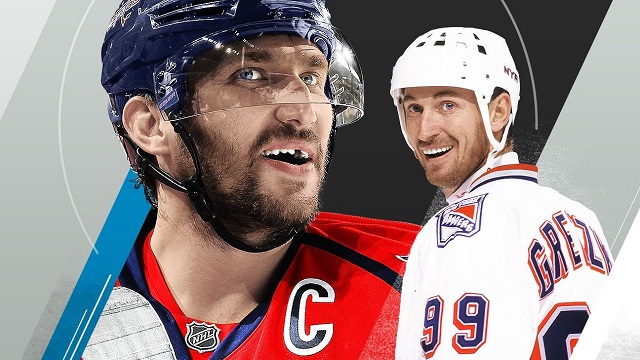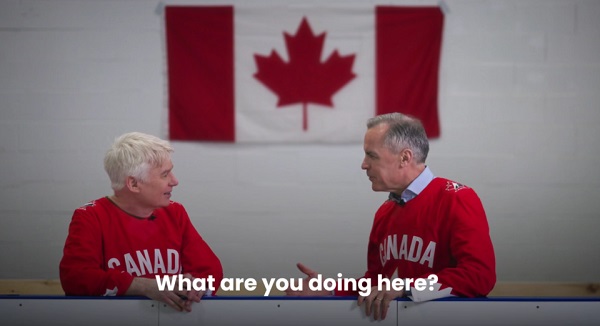Bruce Dowbiggin
Are We Okay With Ovie As Hockey’s Greatest Goal Scorer?

Come meet Bruce Dowbiggin, co-author of Deal With It: The Trades That Shocked The NHL & Changed Hockey. Get your copy autographed, talk hockey. In Calgary Saturday Sept. 28 at Shawville Indigo 11-4. On Saturday Oct. 12 Signal Hill Indigo 11-4. Appearances coming in Fredericton late October and Toronto in early November. Let’s do this thing!
With the grinding war in Ukraine showing no signs of ceasing and Biden-led sanctions doing nothing tangible to deter Vladimir Putin, Russia’s image in the West has rarely been so low. Both sides in the U.S. election accuse each other of being Putin’s stooges, signifying his toxic status. So now might be a good time to ask if the NHL is prepared for a Russian to become the greatest goal scorer in league history.
As the league prepares to start another season on October 4, the top pick in the 2004 Draft is showing every sign that he could pass the game’s greatest in goal scoring. Going into 2024-25, the 39-year-old Capitals star Alex Ovechkin has left the immortal Gordie Howe in the dust. He’s now just 41 scores back of Wayne Gretzky, the Prometheus of NHL scoring. He’s recently broken Gretzky’s record for the most 40-goal seasons in the process. Given health it won’t be the last Gretzky mark eclipsed by Ovie.
1. Wayne Gretzky. 894
2. Alex Ovechkin 853
3. Gordie Howe 801
For his career, the Capitals captain is averaging 0.60 goals per game, meaning at that rate, he could pass Gretzky this season, a pace that Ovechkin is very familiar with. It’s not a given. He scored just eight goals in his first 43 games of 2023-24, but came back strong in the second half of the season to put up a total of 31 for the year, which was the lowest goal-scoring total in an 82-game season.
Hampering him as well might be the ineptitude of the Caps who missed the postseason the past two seasons and who now have few alternatives to draw the defensive concentration away from Ovechkin.
And then there is good health. He’s never played fewer than 68 games in a full regular season. But Ovechkin said he tweaked something mid-training this past summer. He assured the Caps it’s nothing major. “You just have to be smart, and we talk about it with our trainers and the coaching staff. I went there just to see how I feel and feel nice out there,” Ovechkin said after the Caps first practice.
Even in a time of peace this would be interesting to see the public reaction in Canada and the U.S. to a Russian passing Canada’s GOAT No. 99. While the No.1 pick in 2005, Sidney Crosby, has had a squeaky clean image, the Great Eight has been a little salty for some folks. He plays a game Howe would love, dispensing devastating hits as well as brilliant goals. His gap-toothed sneer has not always endeared him to many.
Nor, as we noted in July of 2022, has his proximity to Vladimir Putin himself. In November 2017, Ovechkin started a movement called PutinTeam in support of Putin during the 2018 Russian presidential election. In the past he’s sought to have a foot in both camps. “I don’t know what’s happening out there,” he said in 2022. “I know it’s a hard situation, but it is what it is. You know, I play here, and this is my second home. I don’t want to fight between two countries, because it’s going to be a mess.”

Too late on that front, Alex. Putin’s naked aggression and Biden’s clumsy inability to unseat him (he’s endorsed assassination) have left the West on the brink of a war with nuclear potential. Legendary Czech goalie Dominik Hasek thinks Ovechkin should not be allowed to play in the NHL, and that Russian players be banned. “The NHL should, and could make a decision,” Hasek told reporters. “It’s not only about [NHL Commissioner] Gary Bettman. There are 31 owners of NHL teams, and I think that those people are the most responsible. They can sit in their room, and they can vote and make a decision, but they do not want to make that decision.”
With perhaps a million dead so far and no settlement in sight, few can say where the conflict is headed. Except that it’s highly unlikely the West will be surrendering its sons to the battlefield when NATO runs out of Ukrainians willing to die.

One thing about Ovechkin is certain. As we pointed out in our 2022 book Inexact Science: the Six Most Compelling Drafts in NHL History, Ovechkin put paid to the bias against Russians at the top of the NHL draft. While there had been Russian Hall of Fame selections in the middle to lower rounds of the draft (Sergei Fedorov, Pavel Bure, Sergei Zubov) Ovechkin’s No. 1 overall was considered a risk at the time. He changed the equation.
“It began in 2004, when the Capitals selected Russian phenom Alex Ovechkin, maybe the greatest pure goal scorer the NHL has seen. A number one pick who has lived up to the billing of “generational player,” Ovechkin maybe would have been even more widely hailed as that “Next One” had he developed under the intense hockey media spotlight of Canada, or North America in general.
Never before had an international player earned the kind of accolades Ovechkin received leading up to his draft year. After all, he was only the second Russian ever to go that high on draft day. But the fact he wasn’t a Canadian kid may have tempered the headlines around “Ovie” and made some fans skeptical about his supposed wizardry.
He wasn’t helped by how easily a stacked Team Canada had handled him and his Russians in the World Juniors of 2004 and 2005. In retrospect, “The Great 8” was actually undersold as a generational legend. But all of this made his majestic rookie season as a 20-year-old in 2005–06 more of a revelation than it would have been otherwise.
CAA agent J.P. Barry says that some resistance remains. “Even with Russian players, we’ve seen a hesitance in the past. A few teams have said to me, “Sorry, we just don’t draft Russians. End of story.” I know of several teams that did make that an internal memo. Some even said, “We can’t take a Euro in the first three rounds!” I don’t think there’s any team that could say any of that anymore, though. Way back when, however, there were these unwritten internal policies that were just silly.
There was definitely a period there where teams didn’t want to touch Russians, because they didn’t feel that they could get them to come over. Sometimes they were teams impacted by something negative that happened in the past and let it change their course of action.”
If Ovechkin didn’t entirely smash the Russian stereotype then his countryman Evgeni Malkin, selected right behind Ovechkin in the 2004 draft, sealed the deal. (Ironically the two were rivals for a long time, only reconciling in recent years). Lifetime, Malkin has 444 goals and 702 assists in an injury-riddled career.
To the NHL’s credit, it hasn’t banned or sanctioned its Russian stars as some have done. The country’s teams are banned from international soccer and hockey tournaments and the Paralympics. Russian tennis players Daniil Medvedev and Andrey Rublev (the top-2 ranked Russian male players) were barred from participating at the 2022 Wimbledon. Many Russian artists have seen their concerts cancelled.
For now Ovechkin is walking a tight rope. He’s called for peace without mentioning Russia or Ukraine directly. In May 2022, he reiterated his support for Putin, as well as retaining the Russian president on his Instagram profile photo. Much depends on the progress of the war, and how much Canada and the U.S. are drawn into the combat.
The best advice is probably to keep his head down and his politics to himself if he wants to be celebrated for passing Gretzky.
Bruce Dowbiggin @dowbboy is the editor of Not The Public Broadcaster A two-time winner of the Gemini Award as Canada’s top television sports broadcaster, he’s a regular contributor to Sirius XM Canada Talks Ch. 167. His new book Deal With It: The Trades That Stunned The NHL And Changed hockey is now available on Amazon. Inexact Science: The Six Most Compelling Draft Years In NHL History, his previous book with his son Evan, was voted the seventh-best professional hockey book of all time by bookauthority.org . His 2004 book Money Players was voted sixth best on the same list, and is available via brucedowbigginbooks.ca.
Bruce Dowbiggin
The Rise Of The System Engineer: Has Canada Got A Prayer in 2026?

“Of all tyrannies, a tyranny sincerely exercised for the good of its victims may be the most oppressive. It would be better to live under robber barons than under omnipotent moral busybodies.” C.S. Lewis
One of the aims of logical positivism has been Boomers’ quest to kill Western religion and the pursuit of faith in order to make room for the state. Symbols are banned. Churches are burned. Infidels are rewarded. Esoteric faith systems applauded. Yet, as 2026 dawns, it appears that, not only is traditional religion not dead, it might just be making a comeback with younger generations who’ve grown skeptical of their parents’ faux religion of self.
How? In an age of victim status, traditional religion is suddenly a cuddly TikTok puppy. Hard to imagine that the force that spread imperialism and war across the globe for centuries being a victim. But yes. Only Christians and Jews are singled out for censure In Carney’s Canada The zeal to repeal God has backfired. Faith is off the canvas and punching back. (And we are NOT talking about the Woke pope.)
The purveyors of “old-time religion” will still find themselves facing a determined opponent well on the way to moral inversion. And a compliant population. As blogger Melanie in Saskatchewan points out, “Canadians were sold a calm, competent adult in the room. What they got was an unelected system engineer quietly converting moral claims into financial constraints. This is not leadership. It is non-consensual governance.

The freedoms that make dissent possible are being used to hollow out dissent. The protections meant to guard against abuse are being used to avoid scrutiny. And the law—stripped of its moral imagination—is asked to do what it cannot: resolve psychic conflict through paperwork.”
The sophistry of the superior class demands submission. C.S. Lewis warned of this inversion in God In The Dock. “To be “cured” against one’s will and cured of states which we may not regard as disease is to be put on a level of those who have not yet reached the age of reason or those who never will; to be classed with infants, imbeciles, and domestic animals.”
In Canada that compliant class has embraced Mark Carney as the great stabilizer. “Canadians keep asking the wrong question about Mark Carney,” says blogger Melanie in Saskatchewan. “They keep asking whether he is a good politician. That is like asking whether a locksmith is a good interior decorator.
Carney is not here to govern. He is here to re-engineer the operating system of the country while the Liberal Party provides the helpful stage props and applause track. And judging by how little scrutiny this government receives, the audience seems perfectly content to clap at whatever is placed in front of them, provided it comes with soothing words like “stability,” “resilience,” and “the experts agree”.
Adds Dr. Andrea Wagner, Canadians “hide behind procedure. Behind policy. Behind institutions. Behind NDAs. Behind committees, processes, protocols. Behind phrases like “we’re reviewing this internally” and “that’s beyond my authority.” They hide behind the pretense of empathy while quietly perpetuating injustice. They hide behind performative busy-ness: “I wish I had time,” “I’m swamped,” “I’ve been unwell.” There is enormous power in powerlessness—and Canadians wield it masterfully.”
The problem, says Melanie in Saskatchewan, is not that Mark Carney in full power is incompetent. The problem is that he is extremely competent at something Canadians never actually consented to. Technocrats redesign the machinery so that the outcome becomes inevitable. No messy debate. No inconvenient voters. No public reckoning. Just “the framework,” “the model,” “the standard,” and eventually the quiet conclusion that there is “no alternative.”
And this is precisely the world Mark Carney comes from. ”He did not rise through grassroots politics or party service. He rose through central banks, global finance institutions, and elite climate-finance bodies that speak fluent acronym and consider democracy an optional inconvenience. The man does not campaign. He architects.”
While the Conservative Party of Canada still polls evenly with the Liberals they are playing a different game, one they— with their traditional tactics— are not wired to win in a battle of systems with Carney. This cringeworthy “Keep It Up” endorsement of Carney by former CPC leader Erin O’Toole speaks to why they are further from power than ever.
The manufactured crisis over indigenous Rez school graves illustrates the method. “To call out intimidation or dehumanization is to risk being reframed as the aggressor. The person who names harm becomes the disturbance; the one who weaponizes grievance becomes the protected party. Justice no longer asks what happened, only who claims injury first. This is not accidental. It is the logical endpoint of a culture that has confused victimhood with virtue and pain with authority.

Suffering, once something to be alleviated, has become something to be curated. Identity now precedes evidence; accusation outruns inquiry. The system does not ask whether harm is real or proportional—only whether it can be procedurally contained. And containment, I am learning, is often preferred to truth.”
There are still some who believe there remains a way out of this. Here’s Paul Wells on Substack with a valid conclusion— which most sentient people reached by the end of Trudeau’s first term. “Canada has spent too long thinking of itself as a warehouse for the world instead of designing and building for itself. It’s time for a shared mindset of ambition quality and real investment in physical and human capital so Canadians become Canada’s designers and builders of livable cities rather than bystanders to our own future.”
But it’s hard to square that with the gap Carney’s already has. “The tragedy is that the Liberal Party is perfectly happy to hand (Carney) the country and then scold the public for noticing. If Canadians want a future where choices are still made by voters instead of algorithms and advisory panels, they are going to have to stop applauding this performance and start asking the one question that truly terrifies technocrats and their obedient political enablers.”

This system monolith taking over life is why the abrasive, defiant Donald Trump emerged. Vast segments of America employ him to defy the EU scolds with their censorship regimes. His defiance is categorical— which is why it frightens Canadians. The man from Mitch & Murray delivered a few truths to them and they soiled themselves. Paradise will never be the same!. Bad Trump! But an almost-octogenarian has little runway left himself. Who can continue the resistance to the Carney system engineers?
In the past organized religion was a refuge from the maelstrom of the secular storm. There was comfort in the message. Thus, the Liberals’ current need to destroy faith. So the epidemic of churches burned is ignored. The intrusive demonstrations of militant Islam are tolerated. (Carney says Muslim virtues are Canadian virtues.) History is re-written. Heroes debunked.
If Soviet Russia is any indication, the traditional faiths can survive and act as a bulwark against the technocrats— if they find their Pope John Paul II.. The Catholic and Orthodox faiths furnished a way out from behind the Iron Curtain. As organizations not co-opted by the state in the West religions can provide a moral backbone to expose and defeat the secular globalists.
Whether you are a believer or not they provide a pushback to restore the moral clarity C.S. described. It’s not too late as 2026 dawns. But if nothing is done in the West — if Canada accepts EU censorship and global ID— then writing this column in 2027 could well be defined as a criminal act.
“That which you most need will be found where you least want to look.” Carl Jung
Bruce Dowbiggin @dowbboy is the editor of Not The Public Broadcaster A two-time winner of the Gemini Award as Canada’s top television sports broadcaster, his 2025 book Deal With It: The Trades That Stunned The NHL And Changed Hockey is now available on Amazon. Inexact Science: The Six Most Compelling Draft Years In NHL History, his previous book with his son Evan, was voted the seventh-best professional hockey book of all time by bookauthority.org . His new poetry collection In Other Words is available via brucedowbigginbooks.ca and on Kindle books at https://www.amazon.ca/dp/1069802700
Bruce Dowbiggin
In Contentious Canada Reality Is Still Six Degrees Of Hockey

There’s an observation that only two things bind modern Canada. The federal equalization scheme and hockey, The past year illustrated that equalization is on tenuous ground with talk of separation in Quebec, Alberta and Saskatchewan.
Hockey, conversely, drew the nation closer at the moment that Donald Trump read the riot act to Canada’s elites. After the mens junior squad bombed out of the Junior Hockey championships for a second straight year, a new crisis emerged. To cover their purging of Justin Trudeau and insertion of Mark Carney as PM. the notorious Mike Myers’ Elbows Up homage to Gordie Howe’s elbows was appropriated by the Liberals (In true Woke wonk fashion, Howe never carried his elbows in Carney’s crash position. He kept them by his sides for greater power.)
In February’s Four Nations Cup, played at the height of tension between the two nations, Americans launched a Shoresy brawl in the first game, won easily by Team USA 3-1. As we wrote at the time, “Despite public calls for mutual respect, the sustained booing of the American national anthem and the Team Canada invocation by MMA legend Georges St. Pierre was answered by the Tkachuck brothers, Matthew and Brady, with a series of fights in the first nine seconds of the game.
Three fights to be exact when former Canuck J.T. Miller squared up with Brandon Hagel. (All three U.S. players have either played on or now play for Canadian NHL teams.) Premeditated and nasty. To say nothing of the vicious mugging of Canada’s legend Sidney Crosby behind the U.S. net moments later by Charlie McEvoy.”
Perhaps the least-appreciated aspect of the tension was the booing of the Star Spangled Banner by Canadians who have many Americans playing in their nation’s NHL squads. Leftist Toronto Star scribbler Bruce Arthur, bristled, “You’re damn right Canadians should boo the anthem.”
But in the rematch for the tournament title Canada reversed the tables, winning 3-2 in OT. The rush of nationalistic pride— from people who just weeks before were at each other’s throats over Indigenous claims and pipelines—fed a demographic topsy-turvy that swung Liberals 20 points in the polls, defeating the stunned Conservatives and coming within a few seats of a majority under Carney. Such was the hockey-fed insanity that NDP voters abandoned their far-left mantras to vote for a man who’d only weeks prior was a director of international giant Brookfield Investments.

One other byproduct of the Four Nations was the defrocking of Canadian legend Wayne Gretzky, who’d made a public show of his support for Trumping the 2024 presidential election. He was coldly rebuffed as he shook hands with the Canadian players before the Final game. It was not the finish for Gretz. He was reviled for golfing with The Donald in November, and then mocked for his faceplant appearance at the FIFA 2026 World Cup men’s draw. We wrote, “Gretzy apparently thinks there are countries called “North Mack-a-donia” and “Cur-ack-ow.” Other stabs at geography were almost as tortured.
Bitter Canadians could put up with him sucking up to Trump (he was mentioned as being in the crowd at the DC Xmas tree lighting) but failing geography is unforgivable. The week that started with Gretzky in a photo golfing at POTUS’s Jupiter, Florida, golf course was ending with him pummelled for his abuse of nations with different-sounding names. The Wayne Gretzky Center For Kids Who Want To Talk Good. “

In between the Gretzky episodes, two men who’d shaped modern hockey passed away. In September, on the anniversary of his participation in the 1972 Canada/ USSR series, Ken Dryden died at age 78. “For a generation that watched him develop he was likely the quintessential modern Canadian. Son of a charitable community figure. Educated in the Ivy League. Obtained his law degree. Served as a federal cabinet minister. Author of several definitive hockey books (The Game is perhaps the best sports non-fiction in the English language). Executive of the Toronto Maple Leafs. And more.
“He was on the American telecast of the 1980 U.S. Miracle On Ice at Lake Placid. And the radio broadcast of the 1976 Canada Cup. Ubiquitous media source. Loyal to Canada. And crucially, a son, husband, father and grandfather. If you’d created a model for the citizen of Canada of his times it was Ken.”
A less-loved figure in hockey— but no less significant— died the week after Dryden with the passing of former NHL Players Association director Bob Goodenow, who led the union through three momentous labour fights. Our take: “Tenacious, fearless and bold describes his style. Cuddly and sentimental he was not. The former lawyer and player agent for Brett Hull was not impressed by NHL self-dealing, and he said so. The Harvard product made a bad enemy after he succeeded Alan Eagleson in 1992.

“Today’s players owe him so much for finally giving them self respect. While players in other leagues ate steak, NHL players ate KD. Our book on the topic Money Players is an exhaustive catalogue of dirty dealing and deceit.
“Goodenow convinced hockey players that to earn their worth in the market they had to stick together in negotiations. It would be trying as fans and the media took the owners’ line under new commissioner Gary Bettman when they locked out players in 1994. He didn’t suffer reporters who were NHL echo chambers or old-timers who pined for their good old days of making $1000 a year.
CBA negotiations have never been the same. Player salaries have never been the same. Media covering hockey has never been the same. Eagleson was criminally convicted in the U.S. and Canada for the self dealing revealed by Conway and us. That’s an impressive legacy. RIP the man who reformed pro hockey from within.”
In a hangover story stretching back seven years, the sexual assault trial of the World Junior Hockey gold medalists of 2018 was a field day for narratives in the media and the courtroom. The facts, meanwhile, were stowed away beneath the surface of social media. As we reported in our June 28 column: “Outside diligent reporters such as Katie Strang of The Athletic and Rick Westhead of TSN, the media universe simply assumed guilt in the five players, because. hockey… Social media liberally smeared them as rapists, symbols of women’s degradation.

The five players on trial had been unfairly branded as criminals by Hockey Canada which rushed to condemn them in a quick civil settlement of EM’s charges. HC never consulted them about their side of the story before surrendering the cash. In the end, Ontario Justice Maria Carroccia found EM not “credible or reliable” enough to send the players to jail. While scolding their behaviour she declared the young men not guilty. It was a courageous decision, knowing it would prompt backlash. The Globe&Mail led the charge, declaring “After the Hockey Canada verdict Advocates fear survivors will fall silent”.
As 2026 dawns the outlook for Canadian NHL teams looks bleak. Just two teams would make the postseason today— Edmonton and Montreal— while Toronto, Ottawa, Winnipeg, Calgary and Vancouver wallow below the cut line. Which leaves the Elbows Up crowd pining for a replay of the Four Nations as Canada heads to the Olympic tournament. Don’t expect Wayne Gretzky to ride to their rescue.
Bruce Dowbiggin @dowbboy is the editor of Not The Public Broadcaster A two-time winner of the Gemini Award as Canada’s top television sports broadcaster, his 2025 book Deal With It: The Trades That Stunned The NHL And Changed Hockey is now available on Amazon. Inexact Science: The Six Most Compelling Draft Years In NHL History, his previous book with his son Evan, was voted the seventh-best professional hockey book of all time by bookauthority.org . His new poetry collection In Other Words is available via brucedowbigginbooks.ca and on Kindle books at https://www.amazon.ca/dp/1069802700
-

 Business2 days ago
Business2 days agoVacant Somali Daycares In Viral Videos Are Also Linked To $300 Million ‘Feeding Our Future’ Fraud
-

 Energy2 days ago
Energy2 days agoThe U.S. Just Removed a Dictator and Canada is Collateral Damage
-

 Haultain Research1 day ago
Haultain Research1 day agoTrying to Defend Maduro’s Legitimacy
-

 International2 days ago
International2 days agoTrump Says U.S. Strike Captured Nicolás Maduro and Wife Cilia Flores; Bondi Says Couple Possessed Machine Guns
-

 International2 days ago
International2 days ago“Captured and flown out”: Trump announces dramatic capture of Maduro
-

 International1 day ago
International1 day agoU.S. Claims Western Hemispheric Domination, Denies Russia Security Interests On Its Own Border
-

 International2 days ago
International2 days agoUS Justice Department Accusing Maduro’s Inner Circle of a Narco-State Conspiracy
-

 International1 day ago
International1 day ago“It’s Not Freedom — It’s the First Step Toward Freedom”









